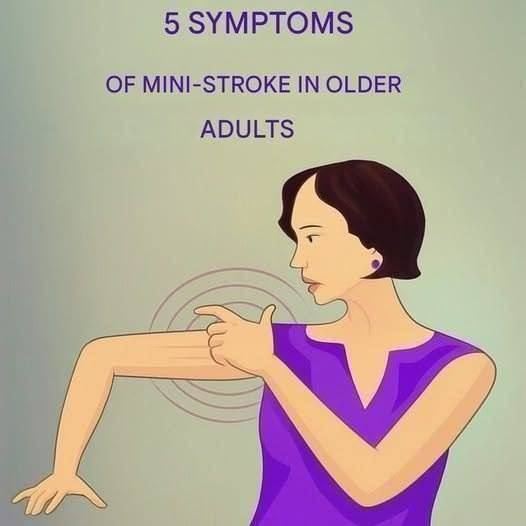A mini‑stroke or TIA occurs when there’s a brief interruption of blood flow to part of the brain. Unlike a full stroke, it does not typically cause permanent brain damage, but it is a serious warning sign. Wikipédia+1
Symptoms are identical or very similar to those of a stroke, but they resolve completely within 24 hours, often much sooner. nhs.uk
For older adults, this event is a crucial red‑flag—not something to ignore.
Top 5 Symptoms to Watch For in Older Adults
Here are five key symptoms, especially relevant for seniors, that should never be dismissed—even if they disappear.
1. Sudden Weakness or Numbness on One Side
One of the most common signs: sudden numbness, weakness or paralysis of the face, arm or leg—typically on one side only. Mayo Clinic
In older adults, this may show up as:
-
Trouble lifting a cup with one hand
-
One side of the face drooping when smiling
-
An unexplained “heavy” feeling in one leg or arm
Action: If you or someone you care for experiences this even briefly—call emergency services immediately.
2. Trouble Speaking or Understanding Speech
Sudden slurred speech, trouble finding words, or difficulty understanding others are major warning signs. nhs.uk+1
In older adults this may manifest as:
-
“It’s like the words won’t come out right”
-
Misunderstanding questions repeatedly
-
Confusion about simple statements
Action: If this happens, don’t wait. Note when it started and seek medical attention without delay.
3. Visual Problems
This includes sudden blurred vision, double vision, or even loss of vision in one or both eyes. Moody Neurorehabilitation+1
Older adults might say:
-
“Everything became fuzzy for a moment”
-
“I couldn’t see out of one eye for a minute”
-
“I felt off‑balance because the vision went weird”
Action: Even if vision returns to normal quickly, this symptom needs emergency evaluation.
4. Dizziness, Loss of Balance or Coordination
Sudden dizziness, trouble walking, imbalance or clumsiness may indicate a TIA affecting the brain’s balance centres. www.stroke.org
In seniors, you might see:
-
Unexplained stumbling or falling
-
Feeling room‑spinning or unsteady without apparent cause
-
Needing support when standing where previously not needed
Action: This is a red flag—especially when combined with other signs. Medical evaluation is essential.
5. Sudden Severe Headache or Unexplained Confusion
While some older adults may think headaches are normal, a sudden, intense headache with no known trigger can be a TIA or stroke warning. Senior Services of America
Likewise, sudden confusion, disorientation or memory lapses—not explained by medications or illness—should raise concern in seniors.
Action: Treat this symptom seriously. If it comes on quickly, see a doctor immediately.
What to Do If You Spot These Symptoms
-
Call emergency services immediately—time is brain. Even if symptoms vanish, the event still counts. www.stroke.org
-
Use the acronym F.A.S.T. to evaluate:
-
Face drooping
-
Arm weakness
-
Speech difficulty
-
Time to act
nhs.uk
-
-
Seek evaluation even if symptoms resolved—diagnosis and prevention matter.
-
Ask for tests: CT/MRI brain imaging, ultrasound of carotid arteries, ECG for heart rhythm, blood tests. www.stroke.org
-
Review and manage risk factors: high blood pressure, diabetes, high cholesterol, atrial fibrillation, smoking, inactivity. Lone Star Neurology
Prevention & Lifestyle Tips for Older Adults
-
Maintain healthy blood pressure; uncontrolled hypertension is the top risk for TIAs/strokes.
-
Stay active—regular moderate exercise helps maintain circulation and brain vessel health. Senior Services of America
-
Eat a heart‑and‑brain healthy diet: colourful fruits/vegetables, lean proteins, whole grains, limit salt and saturated fat.
-
Don’t smoke; limit alcohol; keep weight and diabetes in check.
-
Regularly review medications, especially if older adults are on blood thinners, anti‑hypertensives or have heart rhythm issues.
Conclusion
For older adults, what may seem like a short, strange episode of arm heaviness, a brief blurring of vision, or feeling unsteady is not trivial. It could be a mini‑stroke signalling a ticking clock. The image above titled “5 Symptoms of Mini‑Stroke in Older Adults” is more than a quick list—it’s a call to vigilance. If one of these symptoms occurs, even for a few minutes, treat it as a medical emergency. Early action could prevent a full stroke and preserve health and independence.

